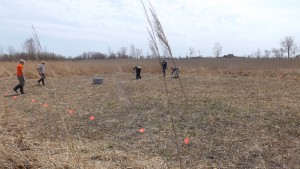Kurt Kowalski of the US Geological Survey – Great Lakes Science Center, shares information on an on-going research project: Applying a Microbial Approach to Phragmites Control.
What is the geographic scope of the project?
We have research plots in Ottawa County, OH and Salinac County, MI.
What are the goals and objectives of your research?

USGS field crew sets up research plots in Oak Harbor, OH to test the response of Phragmites to fungal inhibitors.
We are conducting research to develop more sustainable strategies for Phragmites management in the Great Lakes. One line of research is focused on microbes and the role they may play during plant invasions. We know that all plants have relationships with microbes, and those relationships or associations can greatly influence colonizing success. Thus, if the associations between invasive Phragmites and its microbes can be disrupted, the competitive advantage of Phragmites may be reduced and native plant assemblages maintained. Our work seeks to define the role of symbiosis between Phragmites and its endophytic fungi and explore opportunities to disrupt or enhance those symbiotic relationships.
The specific goal is to:
- Provide proof of concept to the idea that Phragmites plants grow better when associated with fungal communities. This work may lead to new, more effective options for Phragmites management during restoration projects.
Who is involved in this project?
Core Team
Dr. Kurt Kowalski, USGS – Great Lakes Science Center
Wes Bickford, Contractor for USGS – Great Lakes Science Center
Dr. Doug Wilcox, The College at Brockport, SUNY
Dr. Rusty Rodriguez, Symbiogenics
Partners
Dr. Regina Redman, Symbiogenics
Ottawa County (OH) Soil and Water Conservation District
Michigan Department of Natural Resources (http://www.michigan.gov/dnr/)
What is the status of the program and are you seeing results?
The project was set up and the first treatments applied in April 2013. We will begin sampling at the end of the growing season (late August 2013) to assess response to the treatments. Follow-up sampling will occur in 2014.
For more information, check out the project webpage or contact
Dr. Kurt Kowalski
USGS Great Lakes Science Center
1451 Green Road
Ann Arbor, MI 48105
United States
kkowalski@usgs.gov
(734)994-3331
